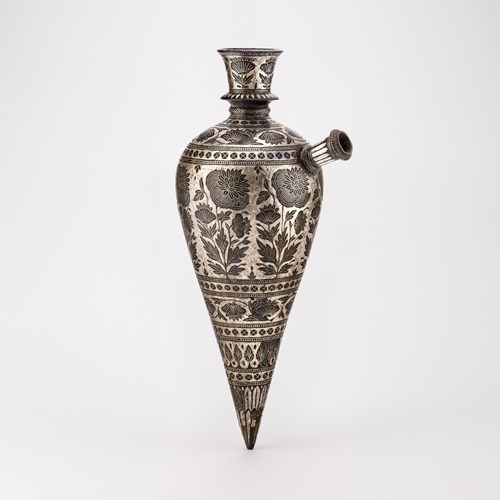A study of an Indian Cuckoo (Cuculus micropterus)
Epoque 19th century
Origine Probably Canton or Macau, China
Medium Pen and ink and watercolour with gum Arabic heightened with bodycolour.
Dimension 26.5 x 30 cm (10³/₈ x 11³/₄ inches)
The luscious display of emeralds and pinks surrounding the cuckoo reveals the artist’s delight in capturing the floral element of the composition. The serrated leaves burst forth as new growth is indicated by lighter green tones. Meandering stems terminate in languorous undulations of petals, whose deep pink edges gently fade to whitish hues. This intoxicating depiction encapsulating the vitality of the rose indicates an artist possessing an advanced understanding of the botanical arts.
First published in 1697, The Mustard Seed Garden Manual of Painting influenced generations of Chinese artists. It noted that “Flowers should carry themselves lightly…They should be drawn with liveliness, accurate colour, in appropriate circumstances, placed properly, and with buds added.” Due to its extensive flowering season, the rose was celebrated in China as ‘the eternal spring flower’ (changchunha) and was frequently painted.
In 1700s the East India Company established its first factory in Canton. Visiting botanists collected specimens from the Fa Tee (‘Flowery Land’) nurseries and commissioned experienced Chinese artists to paint them. In 1797 Lord Macartney returned from China with the ‘Macartney Rose,’ inspiring such adulation for the species that the Dog-rose became celebrated as England’s national flower.
Epoque: 19th century
Origine: Probably Canton or Macau, China
Medium: Pen and ink and watercolour with gum Arabic heightened with bodycolour.
Dimension: 26.5 x 30 cm (10³/₈ x 11³/₄ inches)
Provenance: North American private collection
Literature: Further Literature:
G.G. Khim. 1999. The William Farquhar Collection of Natural History Drawings. Singapore Goh: Geok Khim.
Judith Magee. 2013. Chinese Art and the Reeves Collection. London: Natural History Museum.
Plus d'œuvres d'art de la Galerie


_T637862335883831523.jpg?width=2000&height=2000&mode=max&scale=both&qlt=90)






